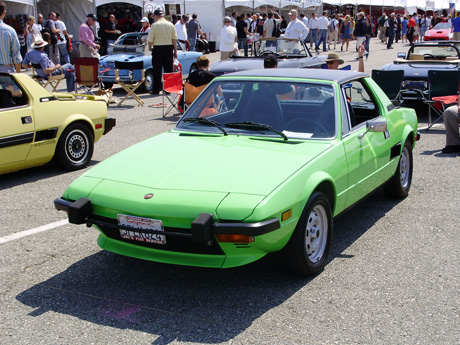
By the early 1970s, some were predicting the demise of the inexpensive sports car. Modern small sedans like the Audi Fox and VW Rabbit were threatening to render sports cars redundant. It didn't help that the standard-bearers for the under-$4,000 sports car class were the MG Midget and Triumph Spitfire.
Both were ancient in comparison to up-to-the-minute designs like the Rabbit and Fox, or for that matter, the Toyota Celica. The enthusiast publications practically demanded that somebody build a cheap sports car on a modern platform.
Fiat was the only company to answer the challenge, and they did it in a way that was nothing short of brilliant. They simply took the existing engine and transaxle from the front-wheel-drive Fiat 128 sedan, relocated it to just in front of the rear axle, and instantly had a modern, cheap, mid-engine sports car. The magazines were unanimous in their praise-their prayers had been answered and a category of cars dear to them had been saved for the time being. Road & Track said, "There is simply nothing it doesn't do well."
Fun to thrash to the 7,000 rpm redline
That is, unless one considers the X1/9's nearly non-existent acceleration. The initial 1,300-cc carbureted version took over 15 seconds to get to 60 mph. Nevertheless, it was fun to thrash to the 7,000 rpm redline. And if speed and acceleration weren't the X1/9's forte, handling certainly was. Absolute grip was impressive-even on its Segway-sized 145 SR 13 Michelin XAS tires, it was in the same league as the Ferrari Dino 308 GT4 and DeTomaso Pantera.
The car's handling characteristics were simply sublime. Even for such a short-wheelbase car, the ride was perfectly damped, never choppy, and there was nothing devious about the Fiat's transient response. Lifting off the throttle in the middle of a bend was not a ticket into the weeds. Steering was delightfully direct, responsive, and light in large part because of the aforementioned narrow Michelins. (It is unfortunate how many modern owners mess up the work of competent chassis engineers by fitting tires that are too wide.)
Finally, the car managed to do what no inexpensive mid-engine car had managed up to the time-it looked great. Marcello Gandini, then at Bertone, gave it an aggressive but not too extreme wedge stance that belied its small 15-foot length as well as giving it decent outward visibility.
Just as those X1/9 fans who feel SCM has unfairly maligned the little cars over the years are possibly getting ready to stow their pitchforks, the reality of Fiat's execution must intrude on the lovefest this article was beginning to resemble.
Maintenance was skipped
X1/9s, like many cars of the period, were grievous rusters. Interior materials were fragile, and poor engine compartment access means that vital maintenance was often skipped when the cars were relatively new. It only went downhill from there, as the cars fell into the hands of the impoverished. Overheating, vapor lock, and gearbox failures (particularly reverse) were also common on early cars.
In 1975, Fiat introduced what must have been the most horrible response to U.S. bumper laws by any manufacturer-basically two tubular bars joined by rubber end caps and mounted on protruding shock absorbers. A better, far more integrated bumper design was introduced later, along with a 1,500-cc engine that allowed the car to at least keep pace with ever-tightening emissions laws.
X1/9s can be reliable-SCM publisher Martin interviewed an X1/9 owner at Concorso Italiano who proudly proclaimed he had driven his car over 388k miles. The "why" question wasn't asked.
Bertone had built the bodies in Turin during the production run of the car, and they were sent across town for finishing at the Fiat plant. Eventually, Bertone took over complete assembly of the cars. The last cars sold in the U.S. were badged as Bertone X1/9s.
Good X1/9s seldom appear for sale either publicly or privately. Although the 1974 cars were modest performers, our sense is that these are probably the most desirable, and if one of the few excellent brightly colored 1974s one sees every year at Concorso Italiano ever comes up for sale, it is probably the only X1/9 with a prayer of seeing the high side of $7,000.
After that, a later 1500 with the more attractive bumpers and the very attractive four-spoke alloy wheels would probably be the most desirable X1/9. Although some prefer the Bertone-badged cars simply because they are the newest, their unattractive flat alloy wheels and garish two-tone paint are liabilities.
And while the X1/9 brigade often blames SCM for the woeful state of the X1/9 market (they once threatened to burn Martin in effigy at their annual meet, and he replied in print, "At least there will be plenty of oil on the ground to get the fire started"), we simply report the fact that for as long as any of us can remember, under $3,000 buys what acceptable cars are out there and we personally know of people who have paid considerably less. Bad news for those X1/9 owners waiting for their cars to join the $10k club, but good news for those of us looking for some cheap, stylish fun.
